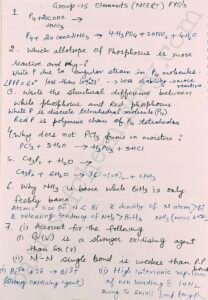GROUP 15 ELEMENTS NCERT EXERCISE PVQS
Notes on group 15 elements and PVQs
For complete explanation of the notes go through the videos 👇
Important points to keep in mind for solving the NCERT exercise and P block group 15 elements P block are:
Phosphorus has vacant d orbital and hence it can expand its valency up 25 while nitrogen lacki aur b l and can have a maximum valency of 3 therefore R3P=O exists and R3N=O does not.
Due to the presence of lone pair on nitrogen atom of ammonia molecule Ammonia acts as a Lewis base.
As we move down the group the size of the element increases which results in the increase in the bond length of E- H and hence the bond strength decreases consequently. Bi-H bond is the weakest among the hydrides of elements of group 15 therefore Bismuth hydride is the strongest reducing agent in its group.
As nitrogen cannot expand its valency beyond four because of the absence of the orbitals in its valence shell therefore it does not form pentahalides or NCl5
Ammonia is a very good ligand because of the presence of lone pair on nitrogen atom that can be donated to the vacant d the orbital of copper ions so ammonia when reacts with copper ions forms coordination complex which is deep blue in colour.
Nitrogen is less reactive at room temperature because of the high bond enthalpy of triple bond present in the nitrogen molecule.
Covalency is defined as the number of shared pair of electrons. Nitrogen atom has four shared pair of electrons in N2O5 so the covalency of Nitrogen in N2O5 is 4
NO2 contains unpaired valence electron which makes it paramagnetic and therefore NO2 is quite unstable which on dimerization gets paired and form stable N2O4 molecule.
White Phosphorus is less stable and more reactive than other allotropes of phosphorus under normal conditions because of the angle strain present in the P4 molecule.
Bismuth in + 5 oxidation state has a tendency to get reduced into more stable + 3 oxidation State so acting as a very good oxidizing agent
When there is a large difference between the electronegativity of the two atoms then there will be the formation of polar bonds in the molecule which results in the hydrogen bonding. Hence hydrogen bonding is present in the molecule like NH3 but it is absent in PH3
In PCl5 Phosphorus is sp3d hybridization it has 3 equatorial bonds and 2 axial bonds. Since 2 axial bonds are repelled by 3 bond pairs which are present on the equatorial position and three equatorial bonds are repelled by two bond pairs so axial bonds are longer in size then equatorial bonds this is the reason all the five P-Cl bonds are not equivalent in PCl5.
For more updates join 👇
Website – https://basicsofchemistry.com/
Instagram – https://www.instagram.com/monabindalgupta/
Facebook – https://www.facebook.com/monabindalgupta/
Twitter – https://twitter.com/monabindalgupta
Quora – https://www.quora.com/profile/Mona-Gupta-202
LinkedIn – https://www.linkedin.com/in/mona-gupta-7b450519a



